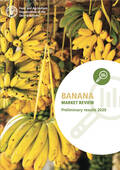Commodity in focus
World banana trade has recorded comparatively high levels of around 20 million tonnes per annum in recent years. Key drivers of trade include supply growth in both leading and emerging export countries, as well as ample global import demand. However, increasingly erratic and adverse weather conditions, rising costs of production, tight producer margins, and the spread of plant pests and diseases are causing severe concern to the industry.
Takeaways:
| On average, more than 90 percent of bananas for export originate from Central and South America and the Philippines. The largest importers are the EU, the United States of America, China, the Russian Federation, and Japan. |
| Banana export earnings help to finance food import bills, supporting the economies of major banana-producing countries. |
| Research in ten banana producing countries found that income from banana farming can account for around three-quarters of the total monthly household income of smallholder farmers. |
| The effects of global warming are resulting in a higher occurrence of droughts, floods, hurricanes and other natural disasters. These environmental concerns render banana production increasingly difficult, uncertain and costly, and threaten to disrupt global supplies and smallholder livelihoods. |
Did you know?
- Bananas are predominantly produced in Asia, Latin America and Africa. The largest producers for domestic consumption are India and China.
- Banana cultivar diversity comprises dessert types, like the Cavendish banana, and cooking types, like plantains. Some cultivars can have dual uses.
- Harsh methods are often used to control irrigation and plant diseases in large-scale banana production, and such production methods can carry significant negative repercussions for the environment and the health and safety of workers and local communities.
- A serious threat to the industry continues to be Fusarium Tropical Race 4 (TR4), a fungal disease affecting banana plants. It is currently confirmed in 21 banana-producing countries. In all reported cases, once a piece of farmland is contaminated with TR4, managing the disease is challenging and costly.
- The global banana value chain is increasingly characterized by the direct downstream activities of large retail chains from the key importing countries. These chains operate independent of traditional fruit companies by sourcing bananas directly from growers and distributors.
Featured Resources
-
Banana Market Review - Preliminary Results 2023
Published: December 2023
-
Strengthening the resilience of agricultural supply chains
The case of fresh fruits and vegetablesPublished: August 2023
-
OECD-FAO Agricultural Outlook 2023-2032
Bananas and Major Tropical Fruits - Outlook included in Other Products sectionPublished: July 2023
-
Published: July 2023
-
Banana Market Review Preliminary results 2022
Published: December 2022
-
Banana Statistical Compendium 2021
Published: October 2022
-
Published: September 2022
-
Banana market review: Preliminary results 2021
Published: May 2022
-
Banana Statistical Compendium 2020
Published: September 2021
-
Published: September 2021
-
Banana Market Review: Preliminary results 2020
Published: June 2021
-
OECD-FAO Agricultural Outlook 2021-2030
Published: June 2021
-
Banana Statistical Compendium 2019
Published: September 2020
-
Banana Market Review Snapshot February 2020
Published: May 2020
-
Banana Fusarium Wilt Tropical Race 4: A mounting threat to global banana markets?
Published: November 2019
-
The changing role of multinational companies in the global banana trade
Published: January 2014






















